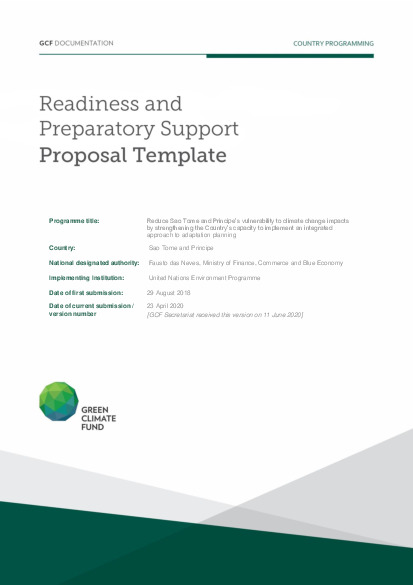Reduce Sao Tome and Principe’s vulnerability to climate change impacts by strengthening the Country’s capacity to implement an integrated approach to adaptation planning

Reduce Sao Tome and Principe’s vulnerability to climate change impacts by strengthening the Country’s capacity to implement an integrated approach to adaptation planning
Sao Tome and Principe (STP) is one of the most vulnerable countries to the effects of Climate Change due to its geography and characteristics including the fragility of its ecosystems and low level of social-economic development. While the Government of STP, supported by key development partners, has come a long way to establish an institutional, legal and policy framework for climate change in the country, several challenges remain including:
- The lack of understanding and capacity among various governmental and non-governmental stakeholders about climate change impacts, vulnerability characteristics as well as available adaptation options and their effects on the population
- Limited consideration of climate change and adaptation options into policies, strategies, plans and programmes especially at sectoral and local levels
- No comprehensive institutional framework in place yet for a coordinated and cross-sectoral approach to Climate Change Adaptation (CCA) in STP
- No national investment plan or mechanism in place in order to guide, coordinate and follow-up CCA investments mostly coming from scattered projects across the country
- Limited institutional, technical and financial capacity in the country to implement, monitor and maintain adaptation interventions
A transition from the project-based traditional modus operandi to an integrated approach to adaptation across all vulnerable economic sectors is therefore urgently needed to deal with climate change in a more coherent and efficient way. This is what the National Adaptation Planning (NAP) process intends to achieve in STP. The main objective of this project is to reduce vulnerability to climate change impacts in STP by supporting the Country’s capacity to implement an integrated approach to adaptation planning at all levels and across sectors. This project will conduct a National Adaptation Planning process that will produce a costed adaptation strategy for the country and provide the tools, mechanisms, system and information with which to replicate the NAP process at regular intervals and mainstream adaptation into existing and future polices, programmes and activities across levels and sectors.
Expected outcomes from this project are as follows:
- Actors mobilized, institutional framework established and national capacity strengthened to develop and implement the NAP in STP
- Evidence base for adaptation planning developed through the production of preparatory elements and gathering of background information for the NAP process
- NAP priorities operationalized into plans at local and national level and supported by an iterative planning framework and monitoring process.
- Access to resources and investments facilitated to implement adaptation priorities in STP
The project will overcome challenges to advance the National Adaptation Planning (NAP) process in STP by (i) placing climate change at the forefront of the political agenda and strengthening the capacity of all stakeholders to advance the NAP process, (ii) improving the quality, quantity and access to climate information and knowledge, (iii) promoting a coherent and integrated approach to adaptation planning and (iv) increasing public resources and private investments in adaptation
Project’s activities will engage and directly benefit a wide range of stakeholders across all sectors and levels of the Saotomean society going from communities, civil society organizations, academia, private sector actors to national government stakeholders and local authorities including both high-level decision-makers and technical staff. At community level, particular attention will be paid to most vulnerable groups including women and youths to ensure their full participation in project activities.